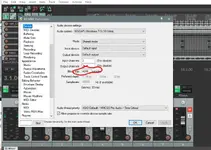LazerBeakShiek
It is a life preserver
What is SPLS Block size again? In Reaper options there is a block/sample size. I kept it low at 144(lowest) to decrease latency. This might not be a perfect fix. My recordings sound thin. Could it be my sample size is too small, and that's doing it? When I increase it from 128(144) to 4096 ( A setting I saw on Todd's screen pic) the drums hit better. Have you tried recording a source with a low and high sample setting? What were your results? Will this make better quality recordings , like Mp3 bit rate does?

If I use 128 sample size, I don't need to nudge it that far to align the project. Great for recording midi input. But is it making cheap quality recordigs for a microphone?
If I use 128 sample size, I don't need to nudge it that far to align the project. Great for recording midi input. But is it making cheap quality recordigs for a microphone?
Attachments
Last edited:

